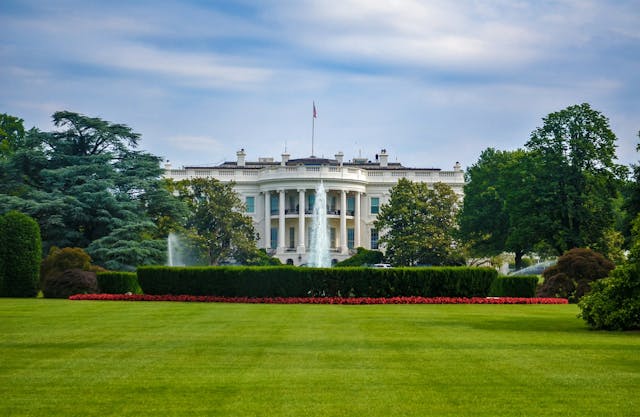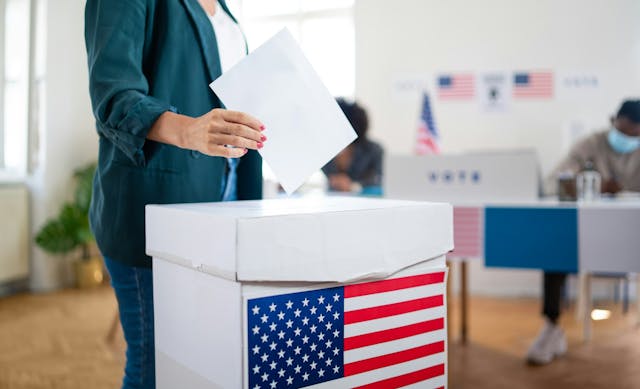Why Do We Accept Partisanship in Judicial Elections?

Photo Credit: Getty Images / Unsplash
The AP headline reads, "Ohio primary: Open seat on state supreme court could flip partisan control." This immediately should raise a red flag for voters, and not because of who may benefit but over a question too often ignored:
Why do we treat "partisan control" of judicial branches as normal?
"It’s been nearly four decades since liberal-leaning justices held a majority on Ohio’s supreme court," the AP reports.
"Democrats hope this is the year that changes, in a campaign that will begin to take shape with Tuesday’s primary. They’ll be choosing a candidate to compete for an open seat on a court that will be at the center of fights over redistricting, public education, health care, environmental issues and criminal justice."
Elections are designed to be a zero-sum contest between two private groups: The Republican and Democratic Parties. Everything in elections is framed in terms of who benefits between the parties.
This should not be the case for a branch of government that is supposed to be impartial and nonpartisan. And yet, the thing that can influence a vote in many judicial elections is whether the candidate has a D or R next to their name.
Or, how campaigns, ads, and the press influence voter perception.
A juridical election can come down to public perception of one national party or the other. Ads for these elections can be framed more around a national partisan narrative than the candidate's record.
And, a judicial election -- particularly state supreme court elections -- can see millions of dollars spent by PACs, parties, and candidates to influence the outcome.
Voters are then expected to trust the impartiality of a branch of government that is supposed to keep the other two partisan-controlled branches in check.
Judicial Elections in the US
Like with any election system, each state dictates their own rules, so navigating state-by-state elections can get a bit complicated. Here is a quick breakdown of what judicial elections look like in the US.
Most states put it to voters for the election and/or retention of judges. In fact, according to Ballotpedia, there are only 7 states without judicial elections of any kind.
Nearly half the states that hold elections for appellate and trial courts use partisan election systems.
When looking specifically at state supreme court justices, the number of states that hold elections drops to 33, 7 of which conduct purely partisan elections while others use nonpartisan elections and/or retention elections.
The price tag on these elections is rising, even in nonpartisan elections. Outside groups spend millions to affect the outcome in individual races. It should come as no surprise that spending goes up when an ideological swing on a court's bench is possible.
According to the Brennan Center, $100.8 million was spent in 17 out of the 26 states that held state supreme court elections in the 2021-2022 election cycle. $55 million of it was from direct contributions to campaigns.
The rest was money spent my outside groups, with the exception of nearly half a million spent by the Republican Party in Montana.
"Several states saw their most expensive judicial election cycles ever, including Kentucky, Montana, North Carolina, and Ohio," the Brennan Center reports.
The most money spent was in Illinois which totaled $28.7 million. Illinois is also a state that uses partisan elections for state supreme court, and about $17.9 million came from outside special interest groups.
Notably, the Wisconsin State Supreme Court race that attracted the nation's attention in 2023 was not included in this analysis. The fight to determine ideological control of the court saw $51 million in total spending.
This was more than 5 times the state's previous record of $10 million spent 3 years prior during a presidential election cycle.
One race equaled half the spending in the 2022 cycle. Wisconsin conducts nonpartisan elections for state supreme court, but hot button issues like abortion and voting rights drew in interest from outside Republicans and Democrats.
Wisconsin set the tone for the 2023-24 cycle. Along with a state supreme court race in Pennsylvania that cost $22 million, the current cycle was predicted to be the most expensive judicial election cycle in US history.
State Supreme Court Ads Use Same Attack Strategies as Partisan Offices
It seemed like everyone threw their hat into the ring in the 2023 Wisconsin Supreme Court race. Following soon after the US Supreme Court's decision to overturn Roe v Wade, outside groups flooded the state with cash.
This also meant a record-setting amount in ad spending -- including TV, radio, and social media. $28 million reportedly was spent on ads in the race ahead of the April 4, 2023, election.
At first, support for Janet Protasiewicz dominated the ad space. For the first half of the general election cycle, Wisconsin Watch reports that ads favoring Protasiewicz outnumbered ads for her opponent, Daniel Kelly, 23-to-1.
However, in the final stretch of the election, ads favoring Kelly not only caught up to Protasiewicz, but surpassed her.
"In addition to the candidates’ campaigns and parties, at least 23 electioneering groups purchased Meta, television, radio or digital ads in the first three weeks of the general race," Wisconsin Watch reports.
"These include political action committees (PACs), such as the Koch brothers’ conservative Americans for Prosperity, and advocacy organizations including the left-leaning American Civil Liberties Union."
It is difficult to completely track the spending data in Wisconsin because state law allows outside groups to get around registration and disclosure requirements if less than half of their spending that year goes into the state.
Protasiewicz, identified as the liberal in the race, made her support for abortion rights explicitly clear in her ads, while outside groups supporting her also released ads portraying Kelly as an election denier.
This attracted interest from Democrat-affiliated and liberal groups.
Kelly's campaign and groups supporting him relied on a go-to approach for Republicans and conservatives by portraying Protasiewicz as being "weak on crime."
The ads on both sides went so far as to attach Kelly's name to images of January 6 and claim Protasiewicz took the side of rapists and criminals. The tactics used are one of the many reasons voters have become disillusioned with elections.
Up until recently, this disillusionment has mostly been seen in partisan elections. But in Wisconsin, it was hard to tell the difference.
A piece published to NBC News' Meet the Press blog looked at 5 ads that defined the 2023 Wisconsin Supreme Court election and the Chicago mayoral election that happened on the same day.
It's an interesting comparison because not only are they elections for two different branches of government, but one is supposed to be nonpartisan while the other is an election in which party and ideological identity are a focal point.
And yet, when looking at the ads -- there isn't much of a difference. While they may speak to different issues, the format and tone are the same. The message sent to voters: fear my opponent or the "other side."
Daniel Kelly is "too extreme" on abortion bans.
Janet Protasiewicz "puts dangerous criminals back on the streets."
This is a standard tactic in partisan politics. In elections across the country, ads are designed not to showcase why voters should vote for a candidate, but rather why they should oppose or be afraid of another candidate.
Why Do We Elect Party Nominees to the Courts?
Back to Ohio. On March 19, voters in the state will advance a Republican nominee and a Democratic nominee to general elections in 3 Ohio Supreme Court elections, including an open contest.
The two races with incumbent justices have only one name on both parties' ballots, so those general elections are decided. The open seat on the bench has one Republican running and two Democrats.
The winner of these primaries will advance as nominees for their respective party. They will be identified by their party affiliation, which will frame the narrative around important judicial issues.
Take a moment to think about the implications. From the beginning, a partisan bias is established on both sides just by the candidates running for their party's nomination for a position that is supposed to be impartial to partisan politics.
Regardless of how the state supreme court is divided, whether it is a 4-3 Republican majority or a 4-3 Democratic majority -- it is still a partisan majority as established by the state's nomination processes.
The parties and the press have no reservations about talking about partisan control over the Ohio judicial branch -- as exemplified by the headline and text of the AP story.
"Ohio Democrats see a possible path to cracking the Republican Party’s longstanding lock on all three branches of state government," the AP reports.
"In November, the amendment enshrining an individual’s right to make reproductive health-care decisions — including on abortion, miscarriage care, contraception and IVF — won with 57% support."
It's all about who wins -- Republicans or Democrats.
And again, this is paradoxical since the judicial branch is supposed to be free of partisan politics. But the election system in Ohio and many other states (when looking at all judicial elections) ensures partisan politics will always play a role.
Is it any wonder why Americans are losing faith in all three branches of government? Especially at a time when hyper-polarization is the single most defining feature of the US political landscape.
Partisan elections for judicial seats invite outside groups to insert national partisan narratives into these elections. They invite candidates to do what they can to appeal to the most partisan voters in low-turnout primaries.
They force judges and justices to apply the same campaign strategies seen in elections for state and federal legislative and executive elections. This may include switching parties when demographics in a district shift.
This, in turn, gives party leaders and legislators an excuse to call for closed primaries -- which would disenfranchise large segments of the voting population -- something that has happened in Ohio.
These elections invite floods of special interest money, toxic and hyper-polarized messaging, partisan machinations, and further disillusionment of the American public and distrust in important US institutions.
However, as witnessed in Wisconsin, nonpartisan elections are not completely immune to partisan interference -- especially if a potential ideological swing in the court is at play.
National politics is gradually engulfing all elections in the US, as more and more races focus on the national divide between the Republican and Democratic Parties.
Voters can see how problematic partisan elections are to the judicial process. But it is worth asking if elections should be used to fill judicial roles period -- especially with how the electoral landscape looks in the US.
 Shawn Griffiths
Shawn Griffiths


